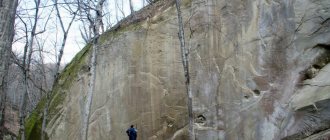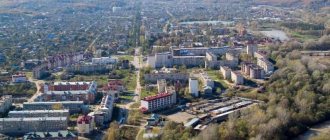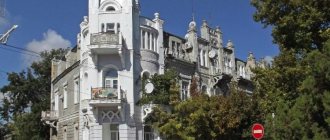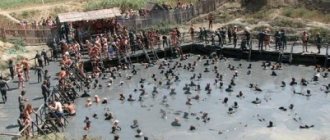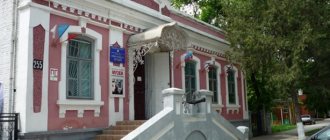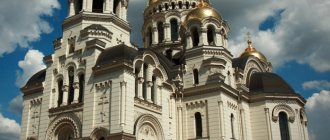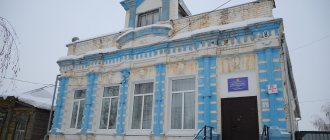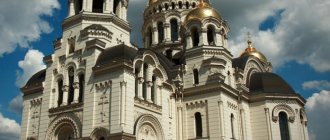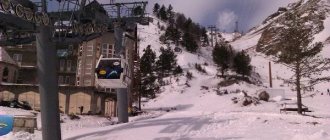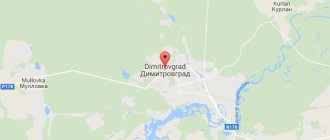Previously, on the lands where the city of Goryachiy Klyuch is located today, the Circassian tribe lived. One day they were awakened by a strange sound. People went outside and saw a fountain gushing out of the ground. The water was hot and smelled like rotten eggs. The tribe's inhabitants were frightened and decided to flee to the mountains.
In the panic and confusion, they forgot about the old man, who could not move independently due to rheumatism. Therefore, he lay in this water for several hours, after which he felt the strength to get up. The old man reached his fellow tribesmen and told them that the water was healing. People decided that this was a gift from God and, in gratitude, began to bring jewelry and coins to the source.
Until the 19th century, the village of Psyfab was located here, which means “hot water” in Adyghe. But as a result of the hostilities that unfolded in this territory, the locals were resettled from their native lands, and the village was named Alekseevsky Goryachiy Klyuch.
If you decide to visit Goryachy Klyuch on your way to the Black Sea coast, an overview of all the Black Sea resorts may be useful to you. Dzhubga will meet you first on the coast - find out if it’s worth spending a few hours exploring this village.
Kaverzinsky waterfall
One of the most picturesque places in Goryachiy Klyuch is the Kaverzinsky waterfall. To get there you need to walk along a picturesque gorge that leads the traveler straight to the waterfall.
The cool, cascading emerald-colored water will not leave anyone without an impression. This is a great place to relax and unwind. If you climb to the top of the waterfall, you can watch how two streams merge together. An indescribable sight.
Travel tips for staying in the city
Goryachy Klyuch is a resort town; the bulk of tourists try to come here in the summer or early autumn. The hottest months are July and August, temperatures can reach 45 degrees, so those who don’t like heat should come in September or early summer. During this period, you can not only calmly treat your health, but also visit the sights without meeting a large number of vacationers. Some travelers even choose winter for their trip, because there are much fewer tourists, and the weather is not the coldest - in February the temperature is already above zero. You can visit the sights even in the cold season; they all take on a new look when covered with snow.
Snow is rare in the city; even in winter you can find flowering plants and green grass here
Since they often come to the city to improve their health, they stay here for at least ten days. There are more than fifteen sanatoriums and boarding houses open in Goryachy Klyuch, which welcome vacationers of any age, selecting the optimal course of treatment for them. The wellness program can be easily combined with visits to memorable places in the city and surrounding area. It is worth booking a place to stay in advance, since there are many holidaymakers who come here for the purpose of recovery at any time of the year.
If the purpose of the trip is only to explore the sights of Goryachiy Klyuch, then you need to set aside three to four days for the trip. Since the majority of natural monuments are located outside the city, and getting to them is not so easy, it will not be possible to travel around them in one or two days. For tourists who do not need health improvement, there are dozens of guest houses and hotels in the city, which should also be booked in advance.
Accommodation in a sanatorium will cost a traveler from 1,500 rubles per day
It is best to come to Goryachy Klyuch by personal vehicle, since moving between attractions will be much easier and faster. For travelers without a car, the city has a public transport network represented by buses. Any route starts from the sanatoriums. You can get to natural monuments located outside the city only by taxi or intercity buses.
The most important gift that a traveler from Goryachy Klyuch can bring for himself is improved health. For loved ones, the best souvenir will be a bottle of mineral water, collected with your own hands in the Drinking Gallery. Also in the city you can buy various types of honey - buckwheat, flower, linden, acacia, enriched with various useful additives. In addition, they sell herbal teas made from Caucasian and Krasnodar herbs. There are quite a few types of tea, all of them differ in their unique composition and medicinal properties. Not only teas are made from herbs, but also pillows that can improve the quality of sleep and relieve some diseases.
Drinking gallery of three springs
Its uniqueness lies in the fact that mineral water is supplied through a special system, and from three completely different sources. They differ from each other in the taste of mineral water, chemical composition and temperature.
It is also important that each guest has the right to take with him half a liter of mineral water from the springs absolutely free. This is a favorite place for many tourists who want to improve their health and have a good time.
Location: Psekupskaya street - 2.
Sights of Goryachiy Klyuch
Goryachy Klyuch is a great place for those who want to improve their health, as well as for those who prefer natural attractions to architectural and museum attractions. Here you will not find merchant buildings, unusual museums or many churches and temples, but their absence is compensated by a great variety of rivers, waterfalls, mountains and, of course, mineral springs.
Healing Park
The park, which is considered the most healing and picturesque place in the city, was created in 1870. Throughout its long history, it has constantly developed and expanded. Today there is everything for a comfortable rest and healthy body: shady alleys, comfortable gazebos, benches and, most importantly, mineral springs.
The park is not marked in any way in terms of its exact boundaries - it seems to merge with the forest that extends right outside the Healing Park
More than a hundred plant species grow in the park, and each hiking trail can take tourists to one of the local attractions:
- Iveron Chapel;
- Dante's Gorge;
- Cockerel rock;
- Key mountain, etc.
At the very entrance to the park there is the Alley of a Thousand Pines, which consists of various types of this tree. Here you can find both ordinary pine and rare species, for example, Koch pine. The alley stretches for two kilometers, and all the trees here have the same shape and height and are located at the same distance from each other. The alley is the creation of schoolchildren who carefully planted trees here several years ago.
There are many birds in the Avenue of a Thousand Pines - and the calm silence is constantly interrupted by their beautiful singing, this is another feature that attracts tourists here
Address: Lenin street.
Iveron Chapel
The chapel was built on the slope of Klyuchevaya Mountain in the second half of the 19th century. For several centuries, a mineral spring flowed here, but in the 20th century, due to changes in mountain strata, the source dried up. All that remains from it is the chalice and the chapel itself, in which the image of the Iveron Mother of God is still kept, and services are held here every Friday.
The Iveron icon, according to the canons of the Orthodox faith, helps in deliverance and miraculous healing from diseases and ailments
Not far from the chapel building there is a monument to Living Water, which has no analogues in any country in the world. It was installed at the site of the concentration of mineral springs in 1914.
The Living Water Monument was erected to mark the fiftieth anniversary of the development of the resort
Address: Healing Park.
Abadzekh (Key) Mountain
The mountain is located on the banks of the Psekups River and rises above the water stream by less than 400 meters. The name "Abadzekh" mountain received from the name of the ethnic group - Abadzekhs, who once lived in this area.
Scientists suggest that Key Mountain appeared about 10-15 million years ago after the greatest tectonic uplift of one part of the river bank occurred here.
Dante's Gorge
The gorge is the result of the joint creation of man and nature. According to legend, it was cut down by local Cossacks, but the exact date of its formation does not exist. Nature made its contribution, because thanks to snow and rain, the gorge widened significantly, and the sharp rocks took on soft features and were covered with moss. Today the gorge is one hundred meters deep, the height in some places reaches fifteen meters, and the width - eight. The entrance to the cave consists of 49 steps carved from stone.
Local residents have a legend: supposedly every morning, at the very early hour, when the Dante Gorge and the surrounding area are completely deserted and quiet, a young girl appears next to the Key Stream flowing along the stairs - this is the mistress of the Dante Gorge
The name "Dante's" gorge received thanks to the creator of the "Divine Comedy" - Dante Alighieri, who described the entrance to hell as a "damp and cool place." This characteristic perfectly describes the climate in the gorge itself.
The gorge perfectly resembles the structure of the World: the bottom of the gorge is a dark and eternally damp Hell, everything is like in the “Divine Comedy”, and after getting out of the dark gorge, a person seems to find himself in Heaven - it’s so bright, light and beautiful here
Ladder of life
The staircase is located on the slope of Klyuchevaya Mountain, a hundred meters from another staircase leading to Dante’s Gorge. There is a legend that once on the top of the mountain the Adyghe people carried out executions - criminals were thrown off the cliff. However, they were given a chance for salvation - they could escape from death using the stairs, and this is how the modern name Staircase of Life appeared.
Thanks to the Ladder of Life, the death penalty was almost never carried out
Rock Cockerel
The rock was formed more than fifteen million years ago thanks to the waters of the Psekups River, which ground and created the outline of the rock for many millennia. The height of the mountain is not very high - a little less than thirty meters. It got its name thanks to local holidaymakers who once decided that its image was similar to the comb of a rooster. However, several centuries ago it had a different name - the Rock of Salvation; it was from it, paradoxically, that the Adyghe tribes threw off criminals.
In 1864, just in time for the arrival of the Great Russian Prince Mikhail Nikolaevich, a gazebo was built on the top of the rock, which to this day is called the royal one.
Psyfabe Fortress
On the Cockerel rock is located one of the oldest defensive fortresses in the country - Psyfabe, presumably built in the 5th-7th centuries. The name is rooted in the Adyghe language and means “warm water”. The construction was intended to protect local residents from enemy raids. According to a study conducted by archaeologists, it is believed that the total area of the defensive structure was about two hundred square meters. Only small parts of the fortress have survived to this day, but even from them one can judge how strong and impressive its walls were - their width reaches three and a half meters.
The medieval fortress used to be one of the main defensive structures in Russia
Alexandrovsky spring
Alexandrovsky spring is one of the oldest springs in the resort city. It was thanks to him that a hospital was once formed here. But he gained fame much earlier than the appearance of the health resort. It is believed that the ancient Greeks used the healing power of local water, evidence of this is the ancient precious coins they brought as a sign of gratitude, and which can be seen here today.
Every year, tourists and vacationers go to Goryachy Klyuch who want to experience the miraculous properties of the mineral water of the Alexander Spring.
Hell's Falls
Hell's Falls is the most mysterious and enigmatic place in Goryachy Klyuch. The water flow here is very strong and noisy, and it is framed by sharp stone ledges. Falling from a twelve-meter height, the water hits the rocks and falls into a deep pool. The waterfall received its name due to the gloomy sensations that beheld what they saw.
Hell's Falls is located in the Chepsi River basin, part of a tributary of Hell's Creek
Ayuk waterfall
Ayuk waterfall flows in a wooded, picturesque area. Its total length, which consists of two large steps, is about nine meters. The water flow foams strongly, which is why it acquires a snow-white hue. Its streams flow into a miraculous bowl, which is perfect for bathing.
Jets of water falling from a nine-meter slope have an unusual white color, this can be explained simply: numerous air bubbles form in the waterfall, and it is they that give this color
Kaverzinsky waterfalls
The waterfalls represent about a dozen water streams, but half of them do not have the required height, so they are not spectacular enough. The largest water cascade is twelve meters high. It falls from a fairly flat stone “wall”, which has symmetrical projections, as if created by human hands. The stream flows into a bowl formed by the water itself. Nowadays tourists often swim here. The water of the waterfall has a milky hue.
Kaverzinsky waterfalls are one of the most visited attractions of Goryachiy Klyuch. These places are famous for their beauty: unusual trees, ferns and mosses, Caucasian fir and yew grow here
Phanagorian Cave
No one knows the exact time of formation of the cave, but it is known that it already existed in the 17th century. Then a Turkish researcher visited and described it; according to him, the cave was large in size, and in its largest hall there was a statue larger than a human one. Unfortunately, no one else was able to find the statue. However, even without it, the cave can be considered perhaps the largest and most mysterious in all of Europe. Previously, pilgrims from all over Russia often prayed here, and Caucasians identified the Phanagorian cave with Tibetan Shambhala.
Local old-timers say that many years ago a cave tunnel led directly to the Black Sea
The cave is located at an altitude of three hundred meters above sea level. The entrance to it has a round shape and a diameter of one and a half meters. To get to the central hall of the cave, you need to overcome a ten-meter tunnel. The length of the entire cave exceeds one and a half thousand meters. According to scientists, some time ago the tunnels were about 25 kilometers long, but later some passages were blocked. The passages in the cave are not very wide; a shallow stream flows along its entire length, but the main hall is quite large - its vault is at a height exceeding human height.
Visiting the cave has a positive effect on health. The local air is weakly ionized, which helps to cure respiratory tract ailments, such as asthma. The temperature here is stable - +9 degrees; while walking through the tunnels, you can meet different types of insects and bats.
Bald Mountain
Bald Mountain rises on the banks of the Psekups River and its tributary Kaverze. The highest point is 423 meters above sea level. Although the mountain has a characteristic name, it does not reflect reality - there is a dense forest on it, in which you can find rare Pitsunda pines.
Some trees that grow on the slopes of Bald Mountain are quite old - they are already more than a hundred years old
On the mountain there is a monument dedicated to the soldiers who died during the Great Patriotic War, who defended Goryachy Klyuch from enemy attacks.
Podnavisla fortification
The settlement received its name due to the nearby mountain called Navisla. In the 19th century, a farmstead was formed under its slope, which was named Podnavisla . During the Great Patriotic War, the settlement played an important role for Soviet soldiers. Here the soldiers organized shelter and defensive structures that saved many people from death. The wounded were also treated here, and the dead were buried right on the territory of Podnavisla. At the end of hostilities, the farm was abandoned, and Arshaluys Khanzhiyan, a girl who nursed wounded soldiers and promised never to abandon them, remained to look after it. So she kept her promise, living alone on the farm for more than fifty years. She died at the end of the twentieth century and was buried here.
In 2000, a memorial was erected on the territory of the settlement in honor of the fallen soldiers, and two years later the Arshaluys monument was erected. In addition, two small churches were built nearby - an Armenian and a Russian one, and in the house in which the heroic woman lived out her life, a museum was opened telling about her life. Now the settlement has become a kind of Mecca for people who come here to honor the memory of the dead.
Photo gallery: Podnavisla Castle
The highest point of Mount Navisla rises at a distance of 704 meters above sea level
During the Great Patriotic War, Goryachy Klyuch was relatively calm for only one year, and already in August 1942 military operations came here
Arshaluys passed away in 1988. The Russian chapel was built in memory of Soviet soldiers who died on this land
The stone Armenian chapel was erected in memory of the Armenian girl Arshaluys
Drinking gallery of three sources
In the gallery you can taste the water that came here from three different sources. Each liquid has its own special taste, chemical composition and temperature. Anyone can get 0.5 liters of mineral water for free.
In the very center of the city, right in the sanatorium complex, there is a Drinking Gallery, into which water from three mineral springs flows through a special pipeline: No. 21, 58 and 104
Address: Psekupskaya street, building 2. Opening hours: 7.00–19.00, break - from 14.00 to 15.00.
Museum of History and Local Lore
The museum began its work in 1864, becoming the first such institution in the entire Caucasus. The excursions are designed for visitors of all ages. The local exhibitions tell about the ethnography of the region, its flora and fauna. The museum also presents archaeological and geological finds that highlight the history of local lands.
The Museum of History and Local Lore is located in a small building, and the number of its exhibits does not exceed 6,000 items
Four halls are open to visitors, designated for a certain period of time:
- the first - antiquity and the Middle Ages;
- the second - the period of formation of the Hot Spring;
- the third - the years of the Great Patriotic War;
- the fourth - the modern history of the city.
Near the museum building there is a monument to Alexander Sergeevich Pushkin, who loved the Caucasus very much and lived here for several years of his life.
Address: Lenin Street, building 132. Opening hours: 9.00–17.00, closed on Monday. Ticket price: from 50 rubles.
Bridge of Hope
The first bridge across the Psekups River was installed at this place a century ago. It was narrow and shaky, and during the Second World War it was partially destroyed. They did not dare to restore it, considering that it would be better to build a new bridge; the remains of the old one remained in place. The modern building is 70 meters long, suspended on steel cables and is one of the largest structures in the entire Caucasus.
The Bridge of Hope got its name thanks to a resort woman who realized that Goryachiy Klyuch is the very place needed by a person looking for relaxation and healing.
Arch with lions
The construction of the arch was completed in 1914, as evidenced by the inscription on one of its columns. On the second, the date of foundation of the resort is carved. The height of the structure is about five meters, and it was installed at the entrance to the Healing Park. Later, the park expanded its territory, so the arch moved inside.
Lions in the Caucasus are not a fiction; many years ago, even in ancient times, these powerful animals lived here; they were forced to leave these places by the people themselves, who mercilessly exterminated lions, hunting them for their valuable skin and large amounts of meat
After the end of the Second World War, sculptures of lions tormenting boars were installed near the arch. This picture symbolizes a person’s struggle with his illnesses and victory over them.
Iveron Chapel in the rock
The Iveron Chapel in the rock is located at the foot of Klyuchovaya Mountain, built right into the rock. A very unique place. It was built in honor of the Iveron Icon of the Mother of God.
The chapel is located in the place where the ferruginous Iveron spring flows. It is famous for its life-giving power and gives health to everyone. The uniqueness and peculiarity of this place does not go unnoticed; thousands of tourists visit the chapel to maintain their health and the health of their family and friends.
Location: Lenin street - 2.
Mountain (Healing) Park
If you reach the end of the fragrant Alley of a Thousand Pines, you can see a sculptural composition with a small fountain, similar to a 3D copy of the city coat of arms - an amphora with healing water and an arch, with an inscription on the pediment informing that the Mountain Park begins next, and the resort already 140 years old. This is not the only arch in the park. One of the calling cards of the city is a more modest in size, but no less beautiful arch with two lions at the foot. It was erected in honor of the 50th anniversary of the resort.
The old entrance to the Mountain (Healing) Park is an arch from 1914, erected for the 50th anniversary of the resort.
The huge park has many picturesque alleys; sculptures and art objects; places where you can have a tasty snack; retail outlets that sell medicinal herbs and herbal infusions, honey, etc. health products. The mountain park was specially laid out in such a way that it organically merges with natural forests. Directly from the alleys of the park you can get to various hiking trails that take travelers to local attractions and, preventing them from getting lost in the forest, return them back to the sanatorium-resort complex. The park also houses a drinking pump room - a gallery of mineral waters.
Bogatyrsky caves
They were formed by compacting sandstone over many years. According to legend, they were created manually by man. But there is no exact explanation of their origin.
The appearance of the caves is very surprising and interesting. After all, a huge variety of corridors and rooms of impressive proportions will not go unnoticed. A large number of rock paintings are one of the features of these caves.
Maltsev Falls, or the Devil's Mouth
On maps the waterfall is indicated by different names, including the ancient Adyghe one - Psechiako. It is located just 5 km from Goryachiy Klyuch. The Devil's Mouth originates from Maltsev Stream (“Erik Maltsev”), along which there are many other picturesque places.
The waterfall itself consists of several cascades with a total height of more than 20 meters. Streams of water pour down, bending around rocky bends, covered in some places with greenery. The spectacle is truly mesmerizing!
Rock Mirror
This natural site is also located in the vicinity of Maltsev Stream. The rock got its name for a reason: it forms an angle of 90° with the ground, and its surface is absolutely flat.
And on bright sunny days, this creation of nature reflects the light of the rays and shimmers softly in it.
Iveron Chapel
A small, cozy sky-blue chapel is located on the outskirts of Goryachiy Klyuch. It is dedicated to the Iveron Icon of the Mother of God. Previously, there was a spring source of “life-giving water” at this place.
This spring is believed to have healing properties. And it was with the consecration of mineral springs that the formation of the resort itself began.
Ruins of the Psyfabe fortress
The medieval fortress used to be one of the main defensive structures in Russia. Numerous archaeological excavations have been carried out on its territory, indicating its active functioning for a long time. According to some versions, it could even be a castle that belonged to one of the princes of those times.
However, now it is just an ancient architectural monument, photographs and descriptions of which can be found without problems. At the site of the fortress you can see ruined walls and impressive remains of towers - a tragic combination of former power and current dilapidation. It is located on the Cockerel rock, which will be discussed below.
Rock Cockerel
This rock, which really resembles the head of a rooster in shape, is located within the city. There is an observation deck on it, and in the warm season local residents usually swim under it. They do this for a reason, but because of an old belief.
According to legend, a young man with a broken heart decided to send a curse on his beloved - and this angered the spirits who imprisoned him in this rock. Now he mourns his action every day, and his tears flow down the rock. People bathe in them because they believe they have magical powers.
Phanagorian and Cat caves
A visit to the Phanagorian and Cat Caves is suitable for brave people with experience in hiking and good physical fitness.
The easiest way to reach this area is by car. An alternative would be to take a minibus to the village of Fanagoriysky, 12 km from which the caves themselves are located.
Not far from them is the Ayuk waterfall.
Ayuk waterfall
On the route to the caves you can come across Ayuk Falls - a quiet, calm and peaceful place that could become the subject of a traditional Chinese illustration with its trees hanging over the water.
Near it there are many cozy clearings where you can stop for a picnic.
Bogatyrsky caves
These caves are not scary at all; this kind of entertainment is suitable even for children.
The entrance to the cave is quite narrow, but still easily passable. Inside you can see gently sloping rocks forming natural canopies, tunnels or simply recesses.
Podnavisla tract
It is located approximately 30 kilometers from Goryachiy Klyuch.
In the foothills of Navisla everything is shrouded in greenery. At the foot there is a green clearing - at the head of it there are two chapels, and more than a thousand Soviet soldiers are buried under it.
This is an atmospheric and incredibly beautiful place. However, its history and the life story of its resident, Arshaluys Khanzhinyan, are even more beautiful. But it is undoubtedly worth hearing from a local resident - the niece of Arshaluys.
Psekup dolmens
No one knows how such monumental structures were built by ancient people. There are more than twenty of them on the Psekups River - all in a single composition.
Dolmens are considered an identification of magical peace, since since ancient times they have been either funeral structures or part of a cult. Many come to them to heal, think or cleanse themselves.
Avenue of a Thousand Pines
An alley of a completely even shape, which stretches for 2 kilometers on Lenin Street, in the very center. The alley is rich in a wide variety of pine trees - Kokha and Pitsunda pine, which are located on Mikhailovsky Boulevard.
The pine trees in this area are of the same height and shape. The alley itself is a kind of entrance to the Healing Park and the Hot Spring zone begins. According to history, all the pine trees were planted many years ago by ordinary schoolchildren. Every visitor can taste healing water from mineral springs.
Parks and monuments, streets, natural sites
Rock "Cockerel"
Coordinates: 44.622114, 39.091680 How to get there: to the restaurant “Old Castle” by car or by public transport to the stop “Sanatorium Goryachiy Klyuch”, then on foot; travel time - 30 minutes.
The rock got its name from its top, which looks like a cockscomb. But it is also called the Rock of Salvation, because at the top there is the Psyfabe fortress, where the inhabitants of the settlement hid from enemies.
According to another version, the rock was the last chance for criminals: if they climbed its slope, they were given life.
According to one legend, the “Cockerel” acquired its bizarre shape thanks to an evil magician who, long ago, caught the last unicorn on Earth and chained it between two rocks. But this was not enough for the sorcerer, and he moved the rocks so close to each other that they squeezed like an accordion, trapping the unicorn inside forever.
Dante's Gorge
Coordinates: 44.620588, 39.094105 How to get there: to the “Old Castle” restaurant by car or by public transport to the “Goryachiy Klyuch” Sanatorium stop, then on foot; travel time - 30 minutes.
In its original appearance, the gorge was a narrow fissure in the rocks. But in the 1870s, the territory was improved, a staircase was made, and the swampy clearing was drained. After the work was carried out, the place began to be compared to heaven on earth.
But a path leads to it along the bottom of a damp gorge, which people call the hellish road. Thanks to this opposition, an association arose with Dante, who wrote the Divine Comedy, and the gorge was named after him.
According to another version, the place got its name from the evil witch Danta who lived here. She threatened to destroy the whole world, then the Great Goddesses killed her. But at the moment of the witch's death, lightning struck and split the rock. A stream of blood ran from the rift. The gates to the world of the dead have opened. Then one of the goddesses sacrificed herself, changing the spell: instead of blood, healing water flowed, and the gate was sealed by the chapel. They say that several souls remain in our world, and every night they wander through the gorge.
Sounding Cave
Coordinates: 44.622114, 39.091680 How to get there: to the restaurant “Old Castle” by car or by public transport to the stop “Sanatorium Goryachiy Klyuch”, then on foot; travel time - 30 minutes.
The cave got its name for its acoustics: you can hear everything that is said on the other side of the river.
At the entrance there is a stone ledge, which tourists nicknamed “the bench.” Sitting on it, you can feel how the sound is reflected from the arches.
Avenue of a Thousand Pines
Address: st. Lenin
The Alley of a Thousand Pines is considered a kind of border of the Goryachy Klyuch resort area. Rare Pitsunda pines were planted by the city's youth in 1958.
Today the number of trees on it is much greater, but the name was not changed because of this. The first 500 meters of the alley are crossed by a road, but then there is a 1.5 km pedestrian zone, which is wider than the largest street in the city.
Bald Mountain
The mountain peaks of Lysaya Gora are located not far from Anapa, in a unique natural triangle of the Hot Spring, the tributary of which is the Kaverze River. Although the mountain is called Lysa, in fact, it has a huge number of green trees and shrubs.
At the peak there is a monument dedicated to the Great Patriotic War. Bald Mountain has its own historical significance for our country.
Description and history of the Hot Key
Goryachy Klyuch is a resort town located in the Krasnodar Territory. It is one of the oldest hydropathic hospitals in the Caucasus. The city is small - it occupies a little less than twenty-one square kilometers. The population is less than 38 thousand people. Goryachiy Klyuch stands on the Psekups River and is surrounded by the Pshaf and Kotkh mountain ranges.
Goryachy Klyuch is a quiet provincial town in which all attention is focused on calm and orderliness, comfort and coziness without noisy pastimes
The city traces its history back to the second half of the 19th century. Before the formation of Goryachiy Klyuch, there was an Adyghe settlement called Psyfab. However, after the end of the war in the Caucasus, the indigenous population left these places. In 1864, thanks to the hot waters of Psekups, a resort was organized on the territory of modern Goryachy Klyuch - a park was laid out, a bathhouse was organized and a military hospital was built. On July 15, the first mineral springs were consecrated, and later this date became the official founding day of the city. Four years later, a place was formed here, called Goryachiy Klyuch. It began to actively develop: factories were built, new wells with mineral water were launched. In 1926, the settlement acquired the status of a village, and in 1930 - the status of a resort village. During the Great Patriotic War, Goryachy Klyuch was captured by the invaders, who severely destroyed the buildings of hospitals and factories, and in addition, burned the main sanatorium of the resort. After the liberation of the village in 1943, it began to be urgently restored so that wounded soldiers from all over the country could be treated here. After the end of the war, they continued to drill new wells with mineral water, and the number of vacationers in hospitals increased greatly. Until 1963, Goryachiy Klyuch served as the center of the Goryachiy Klyuch district, and two years later it received the status of a city. Today, Goryachy Klyuch is not only one of the most important resort hospitals with a mineral water deposit, but also a center for the production of building materials and oil production.
Abadzekh Key Mountain
The mountain peak of Goryachiy Klyuch has been famous since ancient times. It is located almost 416 meters high on the banks of the Psekups River. Abadzekh Key Mountain has this name in honor of the memory of the Abadzekhs, an ethnic group who lived in the valley of the Psekups River.
The mountain has sandy cliffs that were created due to tectonic uplift created by nature.
Historical sites and museums
City Historical Museum
Address: st. Lenina, 34 Phone: 8(6159) 3-52-43 Website: museum.ru/M3197 Opening hours: Mon-Sun 09:00-18:00, Thu 09:00-21:00, Fri 09:00 -17:00 Cost: children - 30 rubles, adults - 50 rubles, excursion - 100 rubles.
The decision to create a museum came in 1998, at which time the collection of exhibits began. Two years later the grand opening took place.
Today his collection amounts to 6 thousand items and is housed in three halls:
- “Archaeology”: materials from ancient and medieval times are presented, the history of the region is told.
- “Kuban Life”: the exhibition is dedicated to the Psekupsky mineral waters and their influence on the formation of the settlement.
- “Military History”: the exhibition covers war times, introduces the personality of intelligence officer Alexander Ivanovich Kozlov, a resident of the city, whose story formed the basis of the films “The Path to Saturn” and “The End of Saturn”.
Drinking Gallery
Address: st. Psekupskaya, 2 Opening hours: Mon-Sun 07:00-19:00, break 14:00-15:00
On the territory of the sanatorium in the city center there is a Drinking Gallery. Water is supplied here from three mineral springs.
Water from the 21st spring is useful for patients with gastritis, as it is saturated with hydrogen sulfide. In the other two - 58th and 104th - it is salty and hot (38-45˚С).
It is recommended to drink it here, but if desired, any visitor can take 0.5 liters with them for free.
Psyfabe Fortress
Coordinates: 44.622145, 39.091691 How to get there: to the restaurant “Old Castle” by car or bus to the stop “Sanatorium Goryachiy Klyuch”, then on foot; travel time - 30 minutes.
In the valley of the Psekuls River there were at one time several fortresses, the most famous of which was Psyfabe. This is one of the most ancient buildings in Russia.
The citadel is located on the top of a cliff - the highest point in the area. Once it had a stone fence, observation towers and shelters for people.
Today, only ruins remain of the fortress.
Ayuk waterfall
Ayuk waterfall is a great place for exotic swimming in a wooded area. The place is unique for its magnificent natural phenomenon, which is due to the beauty of the white cascade of flowing water, which is about nine meters long.
The waterfall has two large steps, which are located on a stream, which has a name - Burlachenkova Gap . Getting to Ayuk Falls is quite easy. You can even drive up by car. A very exotic and picturesque place that every tourist should visit.
Rock Mirror
This natural object, located in the vicinity of Maltsev Stream, got its name for a reason: a significant part of the rock forms a steep angle with the ground, literally 90 degrees, and its surface is absolutely flat and smooth. Climbers often train on the rock, honing their skills.
Rock Mirror.
Museum of Local Lore
This is one of the very first museums in the Caucasus. Its founder is General Popko I.D., commander of the Psekupsky regiment. In addition, he was a historian. The museum attracts visitors of all ages. After all, in this museum you can see many interesting things from the fields of archaeology, ethnography and geology.
The museum also provides information about the history of the Hot Spring. And at the very entrance to the museum there is a beautiful monument, which is dedicated to the great Russian poet and writer, the author of many famous works - Alexander Sergeevich Pushkin, because Alexander Sergeevich lived in the Caucasus for many years.
Location: Lenin street - 36.
Where to go with children
entertainment town "Tigger"
Older children, having visited the healing park and learned about its legends and history, will be able to get carried away just as much as you and plunge into the atmosphere of those times.
For everyone who loves active recreation and likes to travel “at their own pace,” Goryachiy Klyuch is one of the most ideal places. Moreover, it is very close to Krasnodar.
You can park near the Old Castle Hotel. And here the rest begins in the shade of the trees, you can take pictures with fountains in the form of a waterfall and a mill. There is a playground for children, and adults can enjoy tasty treats in the cafe if they need refreshment. Next we cross the bridge over the Psekups River and here it is - the park area of the city of Goryachiy Klyuch. And you slowly begin to wander along the shady alleys, where there are many plants and trees, since the park is practically adjacent to the forest, as if merging with it, sit on benches, wander along the paths, listen to the chirping of birds.
In the center of the park there is a Mineral Glade, next to it there are wells of local sources of mineral water, which from here flows into the Drinking Gallery and the Hydrotherapy Center. Drinking gallery: you buy cups at the entrance (ordinary plastic ones, although you can bring your own if they are available). There are taps with warm mineral water and cold, they are also divided into salted and non-salted. You can drink as much as you like - water is free, many people pour it into bottles with them. In general, this is a paradise for photography lovers - there are figures of all kinds of animals, flowers and water cascades and the well-known golden lions.
There is also a historical landmark (for retro lovers) - the Adyghe Pillar. It is made from a fragment of a Byzantine column and is decorated with inscriptions in Arabic carved into the stone. It was installed long ago for the eternal memory of a certain Khapach Lakshuk, one of the most famous heroes of the Bzhedukho tribe.
We return to the river: we see a small chapel built in honor of the Iveron Icon of the Mother of God. It is carved right into the rock - and blends very harmoniously with the surrounding landscape. On Fridays at 11.00, Akafest (church service) is held there.
Nearby is the healing Iveron spring (ferruginous mineral water) - illuminated in the name of the healer Panteleimon. Feel free to drink this water, and drink a lot - there are rumors that by drinking a bucket, you can miraculously rejuvenate.
We recommend wandering around Dante's Gorge - a very beautiful combination of nature and modern “rock painting”. People tried to immortalize in stone their names, love stories, sacred symbols, even not only their own portraits, but also the faces of their leaders. In general, there is something to look at, and if you wish, I think you won’t be able to resist scribbling a message for history.
Through Dante's Gorge or along the river you can climb the Cockerel Rock - this is a sheer cliff of 28 meters. The top of the rock consists of six teeth, reminiscent of a cockscomb. It is visible from the Don highway. From the Rock of Salvation (Cockerel) there is a beautiful view of the valley of the Psekups river. Anyone who wants forest walks can go beyond Cockerel into the forest. In general, you can spend the whole day here!
For those who want new experiences, one of the most easily accessible natural attractions of Goryachiy Klyuch is the Bogatyrsky Caves. Even with small children you can easily reach them. Drive past Goryachiy Klyuch along the M-4 Don highway and turn towards the village of Fanagoriyskaya. You move along the road past the “Charming Polyanka” tourist center. And on the right you will see a small path up the mountain.
You climb up through the forest for about 15 minutes - and here they are, the Bogatyr Caves! Those who have already been to the caves advise taking flashlights. At first you climb on all fours, and then the caves widen and you can easily stand upright. There are no living creatures in the Bogatyrsky caves - you don’t have to be afraid, there aren’t even cobwebs there. There are so many people there, especially during the season, that all the living creatures have long been scared away. The caves are made of sandstone; it absorbs water well, so it is not dirty there. Ordinary pants and sandals with good soles will be enough).
Dante's Gorge
This is one of the main attractions. Getting to the place is quite easy. Basically, all locals know the way to this amazing place. Dante's Gorge has this name in connection with the famous poet Dante, who wrote the work “The Divine Comedy”. In the work, he described the road to Hell, as well as in the gorge itself it is always damp and cool. A natural mountain stream flows along the very bottom of this gorge. And everyone can walk along the gorge. Both adults and children. A very interesting and fascinating place.
Unique natural places
The main attractions of Goryachiy Klyuch are nature and its most beautiful places.
Waterfalls
What you definitely need to see in Goryachy Klyuch are its picturesque waterfalls:
- Hell's Falls. Agree, a sonorous name, and at the same time mysterious. People called it that for its resemblance to the kingdom of the dead. By the standards of waterfalls, it is not high (only 12 m); from sharp, ominous-looking stones, water rapidly falls down into a deep bowl. However, the nature around is so fragrant that the overall picture is not at all frightening, but picturesque. The road to the waterfall is not easy. If you are new to such routes through mountains and forests, then it is better to go with a tour of rocks and waterfalls for the first time.
- You can go to another beautiful waterfall - Ayuksky. It is located 10 km from the Phanagorian village. The flow of water is especially impressive because it flows in two steps.
Among the numerous waterfalls in the vicinity of Goryachiy Klyuch, there are others that you can reach on your own. Each has its own name and an interesting legend - Chepsinsky, Berendey, Sobachkin, Kesukh, Maltsev, Mouth of the Devil, Kaverzinsky, Dolmenny. You just need to set aside a day, stock up on provisions and go on an unforgettable journey. Don’t forget your gadgets, you will take photos at every step, because the places are indescribable.
Rocks
What else you must see in Goryachy Klyuch are the numerous, beautiful rocks with interesting names:
- Mirror. The rock received this unusual name due to its ability to reflect nearby objects. At the top it is steep and smooth, and at the bottom it has a negative steepness. Professional climbers often conduct their training here.
- Temptations. The rock is not high, only 10 m, and many tourists think that they can climb to the top without any problems. But due to the sheer steep slope, not everyone can do this. So the temptation remains to go conquer the rock again.
- Natashkina. Local residents named this rock in honor of a girl from Krasnoyarsk, Natasha, who was vacationing in their area. She constantly praised the nature of her native land, but at the end of the vacation she admitted that some local natural attractions were more beautiful than those in her homeland. She especially liked the high rock (32 m), which after the girl’s departure received the name Natashkina.
- Monastic. These rocks have a very interesting structure; they consist of many grottoes and niches. A long time ago there was a landslide here that covered the ancient monastery, hence the name of the rocks. At their feet there are two mineral springs – ferrous and hydrogen sulfide.
- Cockerel. The high 28-meter rock is visible from afar. It received this name due to the teeth at the very top, which are shaped like a rooster's comb. Inside the rock, two caves were manually cut out of stone - the Staircase of Life and the Sounding Cave. And at the very top there is an observation deck, the views from it are stunning - the entire valley of the Psekups River is in full view.
- Alquins. These rocks reach a height of 18 m. Where did they get their name? Student Aleftina from Rostov, whom her family called Alka, was vacationing in these places with her dad and brother. While walking along the picturesque rocks, the girl got lost. But brave Alka was not taken aback, climbed onto the highest rock, began screaming and waving her red scarf. Her relatives found her, and from then on the rocks called Alkiny.
Alexandrovsky spring
Within the city limits, near the Psekups River, there is a low rocky mountain, which seems to be cut by gorges and caves, and shrouded in fragrant coniferous forest. At its foot there are mineral springs, one of which is Aleksandrovsky - the oldest, the ancestor of the resort. When people realized what miraculous powers the water from the source had, a health resort was built nearby. People with diseases come to be treated with its waters:
- musculoskeletal system;
- digestive organs;
- of cardio-vascular system;
- male and female reproductive functions.
Hell's Falls
One of the most mysterious places in the Hot Spring is Hell's Falls. Its mystery and mystery lies in the fact that the water in it has a very strong current, there are sharp stones around and falling water from twenty meters hits the rocks, falling into a deep bowl.
The place is truly ominous, especially in the evening and at night. For lovers of mysticism and horror films, this is just a godsend. The landscape itself is quite beautiful and interesting. Apparently, this is the most mystical place in the entire Hot Spring.
Rock Cockerel (aka Salvation Rock)
Another visiting card of the resort city is the Cockerel Rock (another name is the Salvation Rock). It rises above the surrounding area, descending with one steep side directly into the waters of Psekups. The rock got its name because of its peak, which looks like a cockscomb. There are several ancient (or stylized as ancient) legends about the rock. One of them says that in the Circassian village of Psyfab there was such a custom. Criminals sentenced to death were forced to climb this rock. The fact is that no one wanted to carry out the sentence. After all, the law of blood feud reigned, and the criminals also had relatives who, according to this law, were obliged to take revenge. Therefore, the execution of the sentence was given to nature. The criminal fell off the cliff and drowned in the river. If he managed to climb the mountain alive, then he was not executed, but simply expelled from the village. This is why the rock was called the Rock of Salvation.
Rock Cockerel (Rock of Salvation).
Alexandrovsky spring
This is one of the oldest springs of the Hot Spring and is considered the foundation of the entire resort. It is located ten kilometers from the railway station, not far from the Goryachiy Klyuch sanatorium. The mineral spring has truly miraculous properties. And this led to the fact that one day local residents created a real health resort for all people. Moreover, treatment in this health resort is entirely related to the intake of mineral water.
We drink, swim, heal
Recently, the age of the resort exceeded 150 years. The basis for its appearance was underground thermal waters, the temperature of which reaches +60 degrees. The springs differ in the composition of their water. Thus, sulfide chloride-bicarbonate sodium waters are used for external use. They are used for bathing in the treatment of diseases of the musculoskeletal system, nervous system and gynecological problems.
In the drinking gallery you can drink healing water
Carbonated sodium bicarbonate-chloride water is suitable for oral administration. Its composition is similar to that used in Essentuki. However, instead of carbon dioxide it contains hydrogen sulfide, which determines the presence of a specific smell and taste. This water treats diseases of the digestive system.
Its peculiarity and advantage is that hydrogen sulfide is in a bound state and therefore does not cause irritation. You can try the water for a small fee in the pump room of the Goryachiy Klyuch sanatorium. The mineral water comes from underground not only in hot, but also in cold form.
Old coat of arms of the city
The resort essence of the city is reflected in its coat of arms. On a blue background there is an elegant gate with an arch, which in heraldry is considered a symbol of new life. The wide open gate symbolizes the openness and hospitality of the residents. In the center there is a tilted amphora from which water flows - an allegory of the Iveron Spring from Dante’s Gorge. The azure background indicates the Psekups River, on the banks of which the resort was founded.
The resort has six sanatoriums
On the territory of the city there are sanatoriums “Caucasus Foothills”, “Mountain”, “Goryachiy Klyuch”, “Izumrudny”, “Zvezdny”, “Rus”. There are a large number of hotels. Tourists are welcomed by the recreation centers “Kura-Tsetse”, “Forest Provence”, “Mezhgorye”, “Family Fishing”, “Cold Stream” and “Rodnichok”.
Psyfabe Fortress
This place is one of the historical places of the Hot Spring, translated from the Adyghe language means “warm water”. It is located at the very top of Abadzekh Mountain. In ancient times, local residents used this fortress as protection from enemy attacks.
Over time, the fortress has collapsed a little, but still stands firmly in its place. The walls are very thick and durable.
Cenotaph of Hapach Lakshuka, 1717
An unusual monument - a pillar that simply emanates incredible antiquity; it is a cenotaph, that is, an obelisk over an empty grave. There are inscriptions on it in Arabic and Adyghe languages. And this pillar is made of pure marble. More precisely, it is a fragment of a column of an ancient temple, which was erected in the Byzantine Empire.
Cenotaph of Hapach Lakshuka.
This fragment was brought here by the Bzhedukh prince Aity-Khadzhi Khadzhimukov. In 1717, he, together with another noble highlander, Khapach Lakshuk, made a pilgrimage to Mecca. On the way back, Khapach died near Syrian Damascus, where he was buried. Dying during the Hajj to Mecca is considered a blessing from Allah. In memory of his friend, the Circassian prince erected this homemade obelisk. In any weather, the pillar is cold to the touch.
The Legend of Dante's Gorge. Attractions
A long time ago, in one of the villages located here, a girl named Catalpa lived with her husband. She was smart, pretty and virtuous, and she also knew herbs and knew how to heal people with their help. Every day before sunrise, the beautiful healer left to collect medicinal herbs until their healing power dried up, and wandered for a long time along the valleys and mountain slopes. One day, as usual, she went to buy herbs and wandered into a place where she had never been before. A striking contrast appeared before the girl’s eyes - a gloomy, cold gorge, and next to it a wonderful and crystal clear spring, alluring with its murmur and coolness. Tired on the road, she plunged into it, and then lay down on its bank and fell asleep.
Meanwhile, the healer’s lover, taking advantage of her long absence, collected things and what was valuable in the house and fled to the mountains with a woman from a neighboring village. For a long time they met in secret and hatched plans to escape, and then such an opportunity presented itself. When Catalpa returned home, she did not find her unfaithful husband there. She was greatly saddened and waited for him for a long time, every day before dawn she went to that very source, hoping that when she returned back, she would find her husband at home.
Centuries have passed since then, and the girl, who has not aged a day, still comes at dawn to the ringing mountain spring, washes her mesmerizing hair, combs it for a long time on the shore, braids it, and then dissolves in the pre-dawn fog. Local residents, who nicknamed the girl the Mistress of the Cleft, often see this picture. According to legend, every person with a pure soul and thoughts can meet a sad healer if he comes early in the morning to the Key Stream.
What's interesting in the gorge
From the bottom of the gorge, a staircase consisting of 49 steps, cut down in the second half of the 19th century by townspeople, will rise steeply along a picturesque slope covered with green moss. It is called the same as the gorge - Dante's, and leads to another local attraction - the Belling Cave, which has fascinating acoustics, gaping in the wall of the rock-mountain Rooster. Next to the flight of stairs flows the same Key Brook, further downstream it is fed by other, smaller streams, turning into a rather high-water river.
The surroundings of Dante's Gorge are rich in interesting and entertaining corners, not only natural, but also man-made, such as the Iverskaya Chapel, for example. Completely unique, it is completely carved into solid rock, down to the smallest detail, and is located not far from the spring of the same name, which has healing properties and is considered holy. Opposite the chapel, another remarkable man-made object of these regions was built - the Monument to Mineral Water, represented by a pointed obelisk erected here in 1914.
Adviсe
- Wear waterproof shoes - it is wet under your feet in the cave and there is a small stream flowing
- There is a risk of getting dirty on the walls - choose suitable clothes
- Even in summer, the temperature in the cave is no higher than 9 degrees - dress warmly
- If you want to overcome a stalagmite in the middle of a cave, take a rope
- Do not tear off stalactites and scum, or better yet, do not touch them at all - this will preserve the cave for our descendants
- On the way to the Great Phanagorian Cave you can visit the Small Phanagorian Cave and the Ayuk waterfalls
